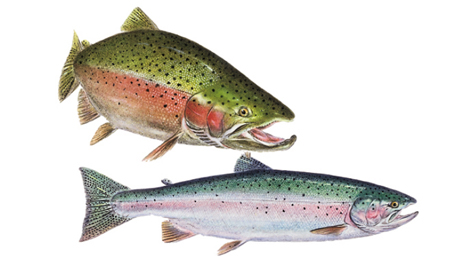Three forms of rainbow trout are common (rainbow, steelhead and kamloops) and often discussed and confused, but it is important to note that these forms are simply variations of the same species:
Rainbow trout: this name is typically reserved for the dark-colored fish with bright, intense markings that inhabit small streams and rivers year-round. The typical coloration includes black spots on the body, and the tail with a pink, lateral stripe.
Kamloops trout: a lake inhabiting trout that is bright and silvery.
Steelhead: The sea and Great Lakes inhabiting fish that return to rivers to spawn. Typical coloration is silvery with dark spots on the body and tail.
Common Names: Rainbow trout, steelhead, kamloops trout
Habitat
Rainbow trout were first introduced into the Great Lakes in 1895 and into the other parts of Ontario between 1883 and 1904. Prior to this, rainbows were only found on the west coast and Rocky Mountains. The current distribution of these fish is mainly concentrated around the Great Lakes and St. Lawrence River. River dwelling rainbow prefer cold streams with moderate flow and a predominantly gravel bottom. The steelhead varieties rarely travel far from their spawning stream.
Spawning Patterns
Between the months of October and May, steelhead return to the rivers to swim great distances upstream to their spawning areas, all the while performing great acrobatics in order to overcome waterfalls and obstructions. Most of the spawning occurs throughout the months of December and April. During this time males are very territorial. Females may make several nests, or redds as they are called, and spawn with many different males leaving as many as 1,000 eggs in each redd.
Diet
The rainbow diet is typically made up of a variety of invertebrate creatures. Plankton, aquatic and terrestrial insects, snails and leeches are all common fare. Under certain circumstances it is also common for rainbow to prey on fish eggs, usually those of salmon. Large rainbows also feed extensively on fish and are very aggressive predators.
Age and Size
Steelhead usually attain greater lengths than rainbows with average lengths being 20-30” and 12-18” respectively. River dwelling rainbows tend to have a shorter life expectancy than the steelhead variety. Rainbows average a maximum age of four, whereas steelhead tend to live to six to eight years.
Fishing Tips
Rainbows offer a wide variety of fishing opportunities that vary from fishing small creeks, large Great Lake tributaries and open-water trips on the Great Lakes. Many small ponds have also been stocked and offer exceptional fishing. River fishing tends to be split into three categories: fly-fishing; float fishing and artificial bait. Fly choice is of great debate and is the subject of many books. Float anglers typically use roe bags or worms drifted under a float (bobber) while many anglers cast artificial baits such as small spoons, plugs and spinners. Openwater anglers mainly troll with spoons or plugs looking for a big steelhead.
Fish illustration ©CURTIS ATWATER (www.natureartists.com/atwaterc.htm)









